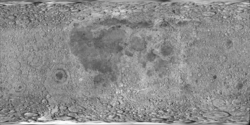Tiselius (månkrater)
| Månkrater | ||
|---|---|---|
| Tiselius | ||
 Tiselius fotograferad av Apollo 16 | ||
| Egenskaper | ||
| Latitud Longitud | ||
| Medeldiameter | 53 km | |
| Djup | Okänt | |
| Kolongitud | 176° vid soluppgång | |
| Eponym | Arne Tiselius | |
| Kartposition | ||
| Månen - Selenografi - ( ) | ||
Hitta fler artiklar om Astronomi med Astronomiportalen | ||
Tiselius är en 53 kilometer stor nedslagskrater på månens baksida, öster om Valierkratern. Tiselius har fått sitt namn efter den svenske kemisten Arne Tiselius, vilket beslutades av Internationella Astronomiska Unionen 1979.[1]
Satellitkratrar
| Tiselius | Latitud | Longitud | Diameter |
|---|---|---|---|
| E | 7.3° N | 177.7° E | 17 km |
| L | 4.6° N | 177.4° E | 12 km |
Se även
Källor
- ”Tiselius on Moon” (på engelska). International Astronomical Union. 18 oktober 2010. https://planetarynames.wr.usgs.gov/Feature/6027. Läst 9 augusti 2018.
Media som används på denna webbplats
Författare/Upphovsman: Rursus, Licens: CC BY-SA 3.0
Replacement for faulty
 (note the ring "around" Saturn!)
(note the ring "around" Saturn!) Red dot, based on the image on en:.
cylindrical map projection of the Moon. The Moon's whole surface was mapped by the Clementine spacecraft in 1994, here North is at the top. The dark floor of crater Plato is at the middle top above Mare Imbrium, while the bright floor and rays of crater Tycho is near the middle bottom below Mare Imbrium. Mare Procellarum is at the near left, and Mare Tranquillitatis is just right of centre and Mare Crisium is at the near right. The far left and far right show the contrast of the mostly cratered farside with small isolated mare.
(c) Gregory H. Revera, CC BY-SA 3.0
Full Moon photograph taken 10-22-2010 from Madison, Alabama, USA. Photographed with a Celestron 9.25 Schmidt-Cassegrain telescope. Acquired with a Canon EOS Rebel T1i (EOS 500D), 20 images stacked to reduce noise. 200 ISO 1/640 sec.
Tiselius crater, on the far side of the moon. From Revolution 3 of the Apollo 16 mission.







